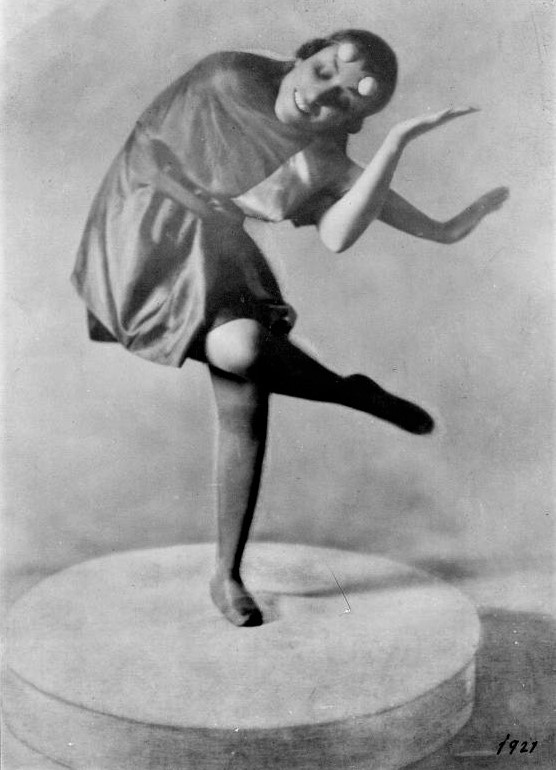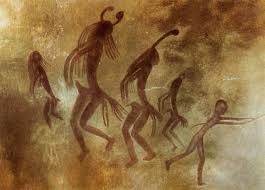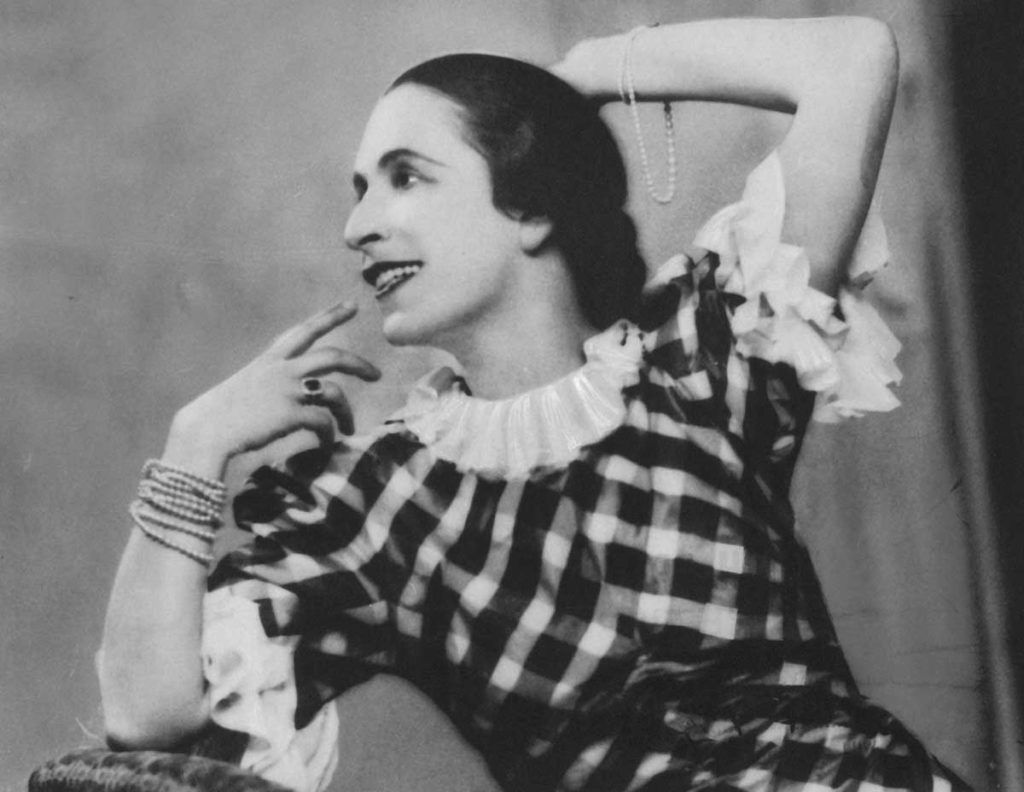
Photo – Gertrude Bodenwieser early performance. She was born Gertrud Bondi in Vienna, 1890. Bodenwieser choreographed over 300 dances and her companies performed in over 300 cities and towns internationally. She was extremely gifted as a choreographer with special talents: in using the unique attributes of her dancers; her use of space as a theatrical medium; and for her dramatic story telling through fluid dance. She was the creator of her own system and aesthetics in modern dance.
Modern Dance from the early 1900s was active in attempting to re-discover and re-plant ancient ideas about the importance and value of dance in culture – and – culture in dance. A culture in the folk or regional or ethnic sense is comprised of: dance, stories, song, music, language, foods, ritual and worship. In many ways the Modern Dancers were revolutionaries and revoulted against what was old, yet, paradoxically they were profoundly inspired by what were the oldest cultures i.e. Indigenous Cultures. Such cultures regard for the value of dance was only one element in an integrated Community.
This week I re-read two books by dancers. One was Dust For The Dancers by Beth Dean (dancer) and her Husband Victor Carell (musician and writer). The other book was An Ecstasy of Purpose…. the life and art of Gertrud Bodenwieser by Shona Dunlop MacTavish (Bodenwieser student, dancer, choreographer).
Anthropology indicates that dance was part of the oldest Cultures. Folk culture until recent decades included regional dance in addition to musical accompaniment and sometimes song texts. In some cases a Culture’s shaman or priest was able in dance, song, herbal remedies, and clown. The dances and ceremonies also occurred at specific times either in the day or night or in a Season or in relation to special occurances including birth, passage of puberty, marriage, death.

The Dean/Carell book, Dust For The Dancers, is a record of their time studying the authentic cultural dances in context within several most remote Indigenous Australian communities from the late 1940s to the early 1950s. In some cases Dean/Carell had a month or more in situations where the Indigenous community danced every night by a traditional campfire adjacent to the Indigenous camp. The places they visited were combined with residents living in the Bush (native land) and residents living on a station (native land which was newly ‘owned’ by settlers using the land to develop it as a huge cattle station/ranch). For example, one settlement, Yuendumu, had 10 non-Indigenous people residing including; 2 nurses, 2 school teachers (a Wife and Husband), 1 government official who fullfilled all legal positions and the rest of the residents were the station owner and family. Some of the Indigenous people were direct employees in the management of the owners house and of the cattle and agricultural station. That settlement had a community of about 400 Indigenous people who lived in the adjacent Bush in an encampment that was about 1 kilometer in length and about 100 metres wide. In the proposed national transition the Indigenous people were at the time still able to survive on foot as hunter-gatherers for 8 months of the year. The other 4 months they stayed adjacent to settlements and received regular food rations.
Dean and Carell were actually able in several settlements to witness dances and rituals which were banned within the community’s Indigenous group from being seen by either its own Women or Men. Since Dean and Carell were non-Indigenous there was no taboo according to the Indigenous communities that would prevent non-Indigenous people from watching parts of sacred initiations. Below I will include an extract from their book describing some of an initiation.
Dean/Carell regularly in their travel research did more than watch. They were in every location able to speak directly with the Indigenous people who spoke some English and/or Pigeon English. Those persons would also translate so that Dean/Carell could interview to learn from dancers of specific dances. More so, in numerous cases Dean and Carell were taught some of those dances, and, they were then permitted by those Elders to share the learned dances with communities far away. It was also known and supported by the Indigenous groups that Dean/Carell were hoping to bring some of those dances or at least some parts to the city stages in Sydney and other Australian cities.
In Dust For The Dancers, Dean/Carell explain many uses of dance for ritual, sharing of legends and related survival knowledge, initiation, ceremony, and for entertainment. Notably the Indigenous People were able to shift between humour and sacred in a matter of seconds or minutes according to their individual personalities and according to shifting needs of the group. The Indigenous People were able to fluidly mix the sacred and the profane.
That fluidity between the sacred and the profane is something I am witnessing as I research my own Community and our Jewish Cultural practices. Clearly, the only way to understand the Jewish Culture is to accept what is obvious in practice that it is both an ancient Indigenous Culture and it has a clear historical lineage demarked and noted within the template of daily practices. That means that each portion of the most complex morning ceremony is historically noted as one moves through the ceremony.
The authentic Jewish practices are in fact dramatic emotionally by intention within, as well as, outwardly observable theatrically in stylised practices through movement. Dean/Carell’s experiences written about in Dust For The Dancers note numerous times that the Indigenous Australian’s practice an inner concentration which in Jewish practice is called kavannah or ‘intention’; combined with very active ritualised practices in both Cultures – Indigenous Australian and Indigenous Jewish. The simplest thing one notices in the Jewish morning ceremony Shachrit is that the congregation stands and sits numerous times designated by Elders of previous generations. Again, central to both Cultures they are guided by the Wisdom of Elders of the Past. The Elders of the Present are expert in having memorised the pathways of the previous Elders. There are also frequent normative adjustments for a variety of practical reasons. For example at our Shul located in the very centre of the CBD, street parking is only allowed until 7am after which parked cars are immediately towed and also fined. So the Weekday morning service must finish a few minutes before 7am. Therefore we do an adjusted, shortened version of Shachrit.
Less apparent outwardly, each of those Cultures have continual and intertwined lineages that can be called Matriarchal and Patriarchal. The central ‘prayer’ or ‘blessing’ for us is the Amidah and that word means ‘stand’. In this case one stands for a relatively prolonged period of about 7 or so minutes, that is just long enough for someone fluent in Hebrew to recite the Amidah. The Amidah is also called Shemoneh Esrei that means ‘eighteen’. But at some point centuries ago, a 19th blessing was added yet the name stays at ‘eighteen’.
Nothing, not one thing, in these Cultures is simple nor straight forward. Even when something appears simple, for those who know better, it is not as simple as it appears.
Another interesting point of commonality is that any blessing or in Indigenous Australian cultures any dance has actions and procedures before the dance or blessing as well as after. One learns to prepare to have the correct or valued intention – kavanah – as well as to have a recognition of departing from that ‘trance’ state.
To the much of the secular world of course – it seems – nothing of spiritual intention makes any sense. Whereas one of the ‘religions’ of the secular is to do physical training which psychologically stands in for the human need for physicallised ritual practice of doing ones ‘obligations’ towards ones betterment. For example, a runner doesn’t just run. They get a clean pair of their preferred socks. Then their best, or preferred, or newest, or oldest pair of shoes. They either tie their running shoelaces by bending over, or by raising their foot onto a chair or by sitting in a chair and crossing their leg over the other knee. Each runner has their own preferred ritual. Likewise one doesn’t just workout. In the orthodox sport way, one must do a warmup then workout then a cooldown. Within sacred practices there is their own system of logic of ‘warmup’ transition for kavanah before the ‘main event’ and a ‘cool down’ transition after each significant ritualised event.
Dean/Carell note a number of specific dances during which there are distinct vocalisations either by the participants and/or by the viewing community. Throughout the Jewish ceremonies there are various times when the congregation is meant to give a vocal response. The simplest to note is that each blessing begins with the words Boruch atai (Blessed are Thou) to which is a congregational response Boruch Hoo (Blessed is He/It) and a few words later at the end of each blessing are the particulars of that blessing and the congregation responds with Amen i.e. the word intended to ‘seal the deal’.
One of Bodenwieser’s numerous choreographies was “I and Thou” the title of Martin Buber’s most famous book published in 1923. Photo below is Gertrude Bodenwieser in Vienna circa early 1930s.

Although there is scant evidence of recordings of either Bodenwieser or Dean’s choreographies, it does appear that Bodenwieser was a highly advanced choreographer, whereas Dean had a particular mission to attempt to bring an understandable performance of ‘Indigenous’ type dance to the Australian cultural centres particularly Sydney and Melbourne. Dean had already developed her own method of studying Indigenous and Folk dances in other countries. Today, some of her work would be deemed as ‘appropriation’. Dean’s most famous work, and some would call it infamous, is dated in that it is politically and aesthetically unacceptable by today’s sensibilities. None the less, that work, using the Indigenous word corroboree for its title was very likely a consciously intended turning point for most of the Australian population which had and has almost no contact with the authentic cultural practices of Indigenous Australian clans in context. Dean did what she felt was the most daring and important thing in her career i.e. Corroboree. The dance-drama was of a theatricallised initiation of a young Indigenous person. Notably, it certainly appears that Dean/Carell had bonafide support and encouragement from the Indigenous communities who hosted them. The dance Corroboree was also inspired from the title piece composed by John Anthill. It’s premiere was for the visit by Queen Elizabeth II in February 1954.
Below is an extracted chapter from Dean/Carell’s book Dust For The Dancers. This chapter is about the final day of a long Initiation. Corroboree‘s central theme was the Initiation. It is my understanding that Dean/Carell had complete support from the Indigenous groups to share their findings. It seemed through reading the book that the Indigenous Elders and communities WANTED their stories shared. Notably they saw distinction between the sacredness in practice being protected in various ways, whereas having their cultures shared as ‘story’ as ‘news’ they were doing everything to ensure that Dean/Carell took the ball and ran with it. For my own interest, as stated already, it is clear to me that my own Jewish Culture is indeed Indigenous particularly in its normative practices which are usually referred to as the misnomer of “Orthodox”. To a large degree, so-called ‘orthodox’ practice is the well established Cultural norm. In the 1990s The Dalai Lama had meetings with a small group of Jewish leaders of different leanings. The Dalai Lama’s main question was related to him witnessing the total demise of his own Culture’s orthodox norm and thus the potential demise of their Culture as a whole. The Dalai Lama wanted to understand that given the unique assaults on the Jewish Culture for over 2000 years, how has the Culture survived leading to how on Earth did it also thrive? Was there something The Dalai Lama could use from that experience? Dean/Carell in their book note repeatedly the the depth of the Indigenous Australians Culture(s) and challenges faced by Indigenous Australians to somehow sustain their Culture(s).
For those who may not have been following my work in recent years, including my books and blog, I view Clown specifically and The Arts in general as a space where people come without realising that they are in fact seeking “Culture”. In my book Clown Secret in one chapter I explain that people coming to Clown are often “seekers”. In our modern societal malaise, Culture replete with its basic collection of the shared elements such as a commonality of dance, food, common spoken language, music, ritual, sacredness is nearly non-existant for most of the Western world and much of the world in general.
Indeed, although Dean’s Corroboree as an artwork may have been out of joint even at its earliest staging, hers and Carell’s wisdom about Culture was and is prescenient. It is my understanding that ‘we’ are ‘meant to’ learn about our shared Humanity by learning from ancient Indigenous Cultures.
Regards from Ira Seidenstein, PhD. If you know others who may relate to my Blogs and work please Share.
www.iraseid.com for blog, Creative Mentorship. The pair of books: Clown Secret; and, Quantum Theatre: Slapstick to Shakespeare are available as Print-On-Demand via any independent bookseller; and via all major online booksellers. Also both books are available in minutes via Kindle.